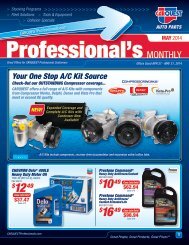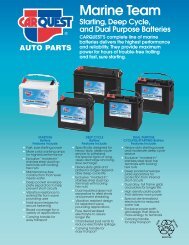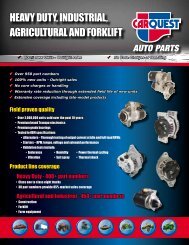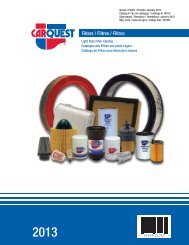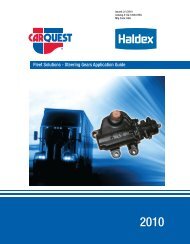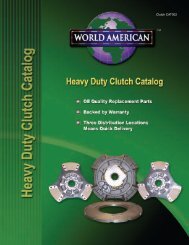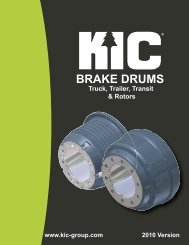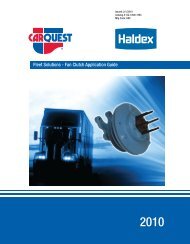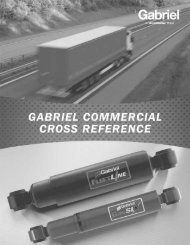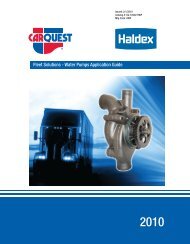Battery Application Guide - CARQUEST Auto Parts
Battery Application Guide - CARQUEST Auto Parts
Battery Application Guide - CARQUEST Auto Parts
- No tags were found...
You also want an ePaper? Increase the reach of your titles
YUMPU automatically turns print PDFs into web optimized ePapers that Google loves.
ALWAYS WEAR EYE PROTECTION WHEN WORKING AROUND BATTERIES!Basic Rules for <strong>Battery</strong> Care & Maintenance.SAFE INSTALLATION (con’t).10.Side terminal batteries need special care. Over-tightening theterminal bolts will severely damage the battery and couldcause a dangerous explosion. Use a special side terminaltorque tool set at 6 to 8 foot pounds to avoid this hazard.11.Start the engine and confirm that, as engine speed is increased,the ignition warning light goes out and/or the ammeterindicates “charge.”12.If the ignition warning light does not go out, stop the engineand check out the alternator regulator system.13.IMPORTANT CAUTIONS:Do not over-tighten connections onto terminals, especiallythose which have studs or nuts integrally molded in position.For side terminals use a torque wrench setting between 6 to 8foot-pounds. For stud terminal work, between 10 and 15foot-pounds.Never use screws in side terminals which are longer than theoriginal, since it would then be impossible to obtain goodelectrical contact without damaging the terminal socket.Never cut or drill terminal posts to adapt them for quick orauxiliary connection. In modern cars incorporating computercontrolled systems, disconnection of the battery will disruptprograms. Follow manufacturers instructions for resetting.NOTE: A memory saver that plugs into the lighter outlet can beused to save the computer and radio/clock memory. Whenusing the memory saver, always follow the manufacturersinstructions carefully.REFERENCE.SPECIAL INSTALLATION PROCEDURES FOR IMPORTS.VENT CAP/HOLD-DOWN INTERFERENCECertain Toyota, Mazda and Nissan models require 24 or 24F groupsize replacement batteries. The standard pod vent caps used onthese batteries may interfere with the top hold-down provided bythese car models. You must use flush cover batteries in theseapplications to avoid hold-down interference problems.TOYOTA/NISSAN RECOMMENDED PROCEDURES:BATTERY SENSOR BYPASSCertain Toyota models are equipped with Toyota’s “ESP System”(Electrolyte Sensor Probe). This system is not compatible withreplacement batteries. Similarly, 1979 and 1980 Nissan 280ZXmodels are equipped with a “battery level sensor” which is alsoincompatible with replacement batteries. To install a replacementbattery, both manufacturers suggest bypassing these systems.TOYOTA • Unplug the electrolyte sensor.• Hook the wire to the blue wire of the windshieldwasher pump.NISSAN • Purchase the “<strong>Battery</strong> Sensor Substitute”(Part # 99996-00202) available from Nissan dealers.• Install according to instructions on part packaging.Proper installation will allow the computer warningsystem to function properly.MAZDA RECOMMENDED PROCEDURE:BATTERY SENSOR BYPASSMazda 626 Coupes (Model Years 1979-81) are equipped with anelectrolyte level sensor. This sensor is incompatible with replacementbatteries. When installing a replacement battery, you mustfirst: Fix the sensor harness to the main harness and removethe warning light bulb from the dash.or: Bypass the sensor by connecting to 12 volts at theignition switch. When connected properly, the warninglight will not come on.See diagrams in next column..CHECK THE CHARGING SYSTEM.The voltage regulator should be checked every 10,000 miles orevery time you change oil. It should be checked immediately if thebattery is hot to the touch, if electrolyte is bubbling or spewingfrom the vents, if your hydrometer reading is below 1.225 orabove 1.300, or if the open circuit voltage is below 12.4 volts orabove 12.9 volts. Over-charging is evident by excessive waterconsumption and/or spewing or bubbling of electrolyte out of thevents. Undercharging is evident by slow cranking or lightsdimming at idle..LOAD TESTING.Follow safety precautions:WEAR PROPER EYE PROTECTION!First perform an open circuit voltage test, then an adjustable loadtest. A load test is the best way to determine if the battery isdelivering adequate electrical performance. Make sure yourvariable load tester is working properly.1. You can't load test a discharged battery. If the voltage isbelow 12.4, be sure to completely charge it before continuing.Refer to the charging chart under “Charging Tips” section forimportant information.2. To avoid sparking and explosive gasses, be sure load tester isOFF and battery is disconnected before hook-up. Use computermemory saver to retain the vehicle’s electronic memory whilethe battery is disconnected.242



